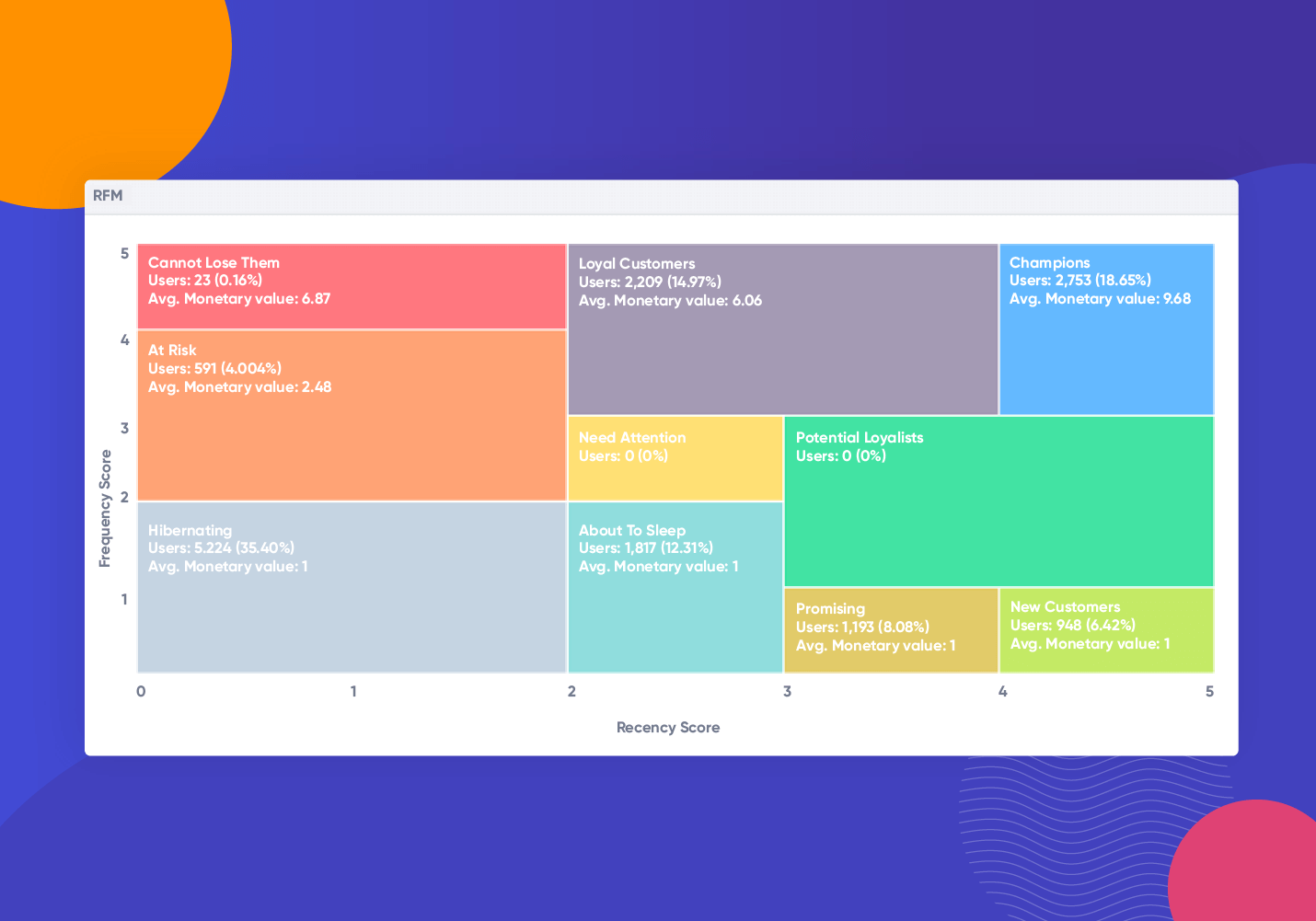Analytics are key to app success. They help you understand who your users are and what they want from your app.
But many companies make the mistake of relying solely on analytics to boost retention. Analytics are only insights, it’s what you do with those insights that matter.
Not to mention, users’ needs evolve and purchase decisions can sometimes happen instantly. If you don’t have a way to quickly take action on those insights, you can’t expect your users to stick around and wait.
In fact, the best apps don’t even wait for users to act — they anticipate their users’ needs before they even realize them.
Let’s take a look at Amazon. They’ve perfected product recommendations and suggestions based on data-driven insights and user buying behavior. And it works really well — Amazon’s recommended purchases result in 35% of their annual revenue*. 
Analytics alone is simply not enough. The right platform not only provides user data, but arms you with the tools to turn insights into action the minute (or a minute before) a user shows intent.
Here are four ways you can use a tool like CleverTap to understand your users with audience analytics and drive retention with engagement tools.
1. Orchestrate Seamless Omnichannel Experiences
Let’s say a user adds something to their cart through your app but doesn’t purchase. Later, they happen to be on your website on a desktop and don’t see the items in their cart. You just drastically reduced the chances of that user converting due to a poor omnichannel experience.
Users don’t see brands in silos. Today’s consumers use an average of 6 touchpoints to interact with a brand, with nearly 50% regularly using more than four*. They’re engaging with your brand across multiple devices — and they expect every experience to be seamless.
This isn’t a bad thing. In fact, the more they interact with your brand across devices, the more you learn about them.
With a rich user profile system, you gain a comprehensive understanding of your users — everything from demographics to transaction history. This allows you to design user-centric campaigns based on their interactions with your brand across all devices. 
Taking Action on Omnichannel Campaigns
- Personalize outreach: Put your comprehensive user profiles to use. Where are they located? What language do they speak? The more you learn about your users, the more you can tailor their experience. Learn what resonates with your users and personalize outreach accordingly.
- Unify messaging: Don’t confuse users by pushing different products on different devices or run the risk of giving conflicting information. Relaying consistent messaging across all platforms keeps your brand honest and reliable — and brings in the right users.
- Engage the way your users want to: Don’t force your users down a single path. Adapt to how your customers want to interact with you and offer opportunities to convert across each touchpoint.
- Evolve your tactics: The work doesn’t end once the campaign goes live. A platform like CleverTap provides real-time insights into campaign performance so you can adjust your messaging as your users’ needs evolve.
2. Group Users Based on Similarities
So you know who is using your app and who isn’t. Now what?
Dividing your users into superficial, basic groups (such as active and non-active) is too generic to be actionable. You’ll need to dig deeper to engage them effectively.
Finding out how recently and frequently your users are engaging with your app gives you better insight into who you should be engaging as well as how you can interact with them.
The Recency, Frequency, and Monetary analysis (RFM) tool automatically buckets users based on how recently and frequently they’ve engaged with your brand. This allows you to actively engage with users based on what customer lifecycle stage they’re in. 
However, not all inactive users are created equal.
For example, the “cannot lose them” segment of users were highly engaged users at one point (high frequency), but they’re no longer as engaged and are at risk of churn (low recency). These users should receive different messaging from the “hibernating user” segment, which represents the lowest recency, frequency, and monetary values — users who were never fully engaged with your app to begin with.
Taking Action on RFM Segments
For users at the bottom of the RFM grid:
- Retain: Users with low frequency and high recency are not familiar with your brand. Help them become regulars by sharing ways to engage with your app such as how to build a playlist or set up alerts.
- Reactivate: Users with high frequency and low recency are at risk of churning. While they are already familiar with your brand, they might just need a little push to get going again. Win-back campaigns and special promotions are a great way to show them what they’re missing.
For users at the top of the RFM grid:
- Monetize: These users have the highest chance of converting. Take this opportunity to send them bundled deals or nudge them toward the next subscription tier, since you know they already love your app.
- Reward: Your champions (high recency and frequency) are your most loyal users — so show them some appreciation. Reward them with referral discounts (since they would probably be the best advocates for your app) or an exclusive look at new products or content.
For more ideas on campaigns to send to each RFM segment, check out Customer Experience: Tools to Build Outstanding Experiences.
3. Boost Conversions with Funnel Analysis
With 71% of users leaving within the first 90 days, it’s safe to say churn is a big problem for mobile apps.*
Understanding how users are navigating through your app can not only reduce churn but help identify ways to improve conversions.
Funnel Analysis allows you to visualize the user journey within your app — pinpointing where users are converting and where they’re dropping off. 
Let’s say you’re an ecommerce app and you want to see every path a user takes from building a profile to checking out. Flows takes funnel analysis to the next level by sharing the different ways users take to get from point A to point B.
Taking Action on Funnel Analysis
- Identify key metrics: Not all key conversions are purchases. Conversions could be building a profile, uploading a photo, or entering a phone number. Once you identify which metrics are essential for the success of your app, you can start building funnels around them.
- Compare funnels: Do people under 30 convert quicker than those over 30? Do users in the US tend to drop off more than users in the EU? Monitoring and comparing funnels can provide insight into why various demographics convert differently and influence app growth tactics.
- Listen to your users: You might think your new users would like a brief video demo as soon as they download your app, but find they drop off as soon as they’re prompted to watch it. Don’t guess how your users want to engage with your app — let the data tell you.
4. Identify Behavior Patterns That Impact Retention
Vanity metrics (like downloads) can be deceiving growth metrics for mobile apps. You learn how many users are downloading your app, but how many are actually staying?
Cohort analysis measures app engagement over time, and groups users based on similar in-app behavior. This tool allows you to look past superficial growth metrics that give you a false sense of success and discover behavior patterns that impact retention.
Let’s take a look at this cohort of users.
Between August 30 and September 6, there were 134,529 new users obtained. As of Day 1, only 26.1% of them are retained, 11.5% on Day 4, and 8.1% on Day 7. This equates to losing 92% of users in just the first seven days.
While your app bleeds users, the impressive growth numbers of new users are masking the real problem of retention — and you continue to make the same mistakes that lead to churn.
Cohort analysis helps separate growth metrics from engagement metrics, so you learn how to not only retain your current users but how to get new users down the right conversion path.
Case Study: Increasing App Engagement for a Fitness App
Let’s say you’re a fitness app, and using Cohort Analysis, you see that a majority of your retained users use your app between 6 and 11 am. Most users who open the app after 3 pm close the app 30 seconds later and 90% of those users become inactive or uninstall within the next month.
Now you have a better idea of how to boost retention: get your users in your app before 11 am. This could involve sending push notifications announcing new workouts in the AM, curating content around the effectiveness of early morning workouts, or reminding users to add an early workout to their calendar the night before.
Taking Action on Cohort Analysis
- Spot trends and tension: Monitor how long different cohorts stay active in your app after they perform certain actions, and see which actions have a positive or negative effect on retention. By combining cohorts and discovering the paths that lead to retention, you can start guiding your users in that direction.
- Learn which users to go after: As you gain more insight into how users engage with your app, you can start targeting your ideal user. This can help fine-tune your acquisition strategies and dramatically boost customer lifetime value (CLV).
Putting Analytics into Action
You can sit around and look at metrics all day, but that won’t keep users returning to your app.
If your metrics are spread across several platforms without a clear understanding of what it all means or how to use it, what’s the point?
CleverTap’s intelligent retention marketing platform helps you:
- Construct a consistent omnichannel experience using a rich user profile database
- Segment users into buckets based on how they engage with your app using RFM Analysis
- Optimize conversions and touchpoints with Funnel Analysis
- Discover data trends and user behavior patterns that influence retention with Cohort Analysis
Want to learn more about how you can improve retention? Schedule a personalized call with our mobile growth experts today.

See how today’s top brands use CleverTap to drive long-term growth and retention
Subharun Mukherjee 
Heads Cross-Functional Marketing.Expert in SaaS Product Marketing, CX & GTM strategies.
Free Customer Engagement Guides
Join our newsletter for actionable tips and proven strategies to grow your business and engage your customers.







